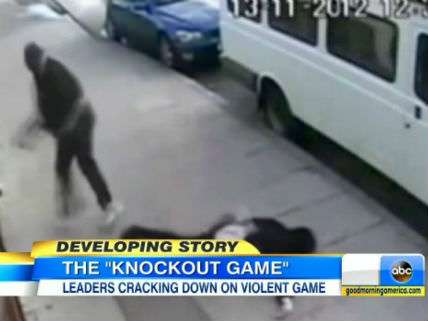Is the Knockout Game a Hate Crime? Is It Even a Game?

Amrit Marajh, the 28-year-old accused of sucker-punching Shmuel Perl, a 24-year-old Orthodox Jew, in the side of the head on Friday in the Borough Park neigborhood of Brooklyn, has been charged with assault, which makes sense, and aggravated harassment as a hate crime, which is harder to figure out. Leave aside the question of whether a criminal should be punished extra severely* when he is motivated by bigotry. (He shouldn't.) According to ABC News, Perl said he "heard his alleged attackers daring each other to punch him out minutes before one actually assaulted him." Hence the assault has been described as the latest example of "the knockout game," a pastime supposedly sweeping the nation in which young assailants dare each other to knock out randomly selected targets with a single punch. But if the victims are picked at random, as the knockout game reportedly requires, can they also be selected based on their ethnicity or religion? ABC does not mention any anti-Semitic slurs or other evidence that Marajh was looking for a Jew to attack, and neither do the accounts in The New York Times, the New York Daily News, or The Jewish Press. So why the hate crime charge? The Daily News story suggests that Perl just happened to be walking down the street at the wrong moment:
Amrit Marajh, 28, had just left a bar on McDonald Ave. on Friday with four friends and was talking about boxing when the knockout game came up, police sources said.
"You can't do that," one member of the group said as they came upon Shmuel Perl, 24, according to a source.
Marajh allegedly said, "Yes I can, I'll do it to this guy right now!" before punching Perl in the face, leaving him bruised.
Marajh's lawyer, by contrast, told the Daily News "this had nothing to do with the knockout game." Also in dispute: whether the knockout game is actually a thing. "Police officials in several cities where such attacks have been reported said that the 'game' amounted to little more than an urban myth," the Times reports, "and that the attacks in question might be nothing more than the sort of random assaults that have always occurred." For example:
Much news coverage of reported knockout attacks includes 2012 footage from a surveillance camera in Pittsburgh of James Addlespurger, a high school teacher who was 50, being swiftly struck to the ground by a young man walking down an alleyway with some friends. Yet the Pittsburgh police said the attacker insisted the assault was not part of any organized "game."
"This was just a random act of violence," Police Commander Eric Holmes said in a televised interview last year. "He stated that he was just having a bad day that day." The assailant saw Mr. Addlespurger, the commander said, "and decided this was a course of action he was going to take."
Once such crimes are relabeled, of course, young thugs who are inclined to attack people for no particular reason may start using the new terminology, thereby retroactively validating it. If Marajh and his friends really were talking about "the knockout game," they were probably discussing what they'd heard from news outlets hyping this supposedly new trend.
*Addendum: Marajh's allegedly anti-Semitic motivation makes a big difference in the penalty he faces. Because he is accused of striking Perl, he presumably was charged with aggravated harassment in the second degree. Ordinarily that offense is a Class A misdemeanor, punishable by up to a year in jail. Charging it as a hate crime knocks it up to a Class E felony, punishable by 18 months to four years in prison.


Show Comments (105)